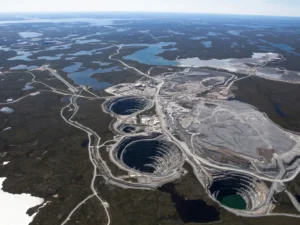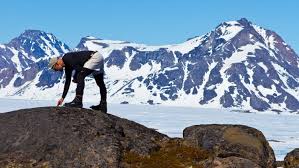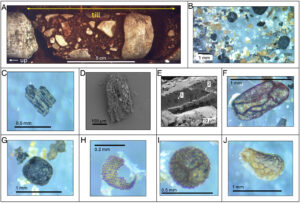
The Lecture
Subduction-related late Quaternary tectonic uplift and sea-level change in the Pacific NW and around the Pacific Rim
This was a Zoom-only lecture.

Quimper Geological Society welcomed Dan Muhs, an emeritus USGS geologist. He provided marine terraces as evidence of tectonic uplift along the Pacific Ocean plate.
In 1979, Seiya Uyeda and Hiroo Kanamori introduced a tectonic model with two end members of a subduction-boundary continuum: the “Chilean” type (shallow dip of the subducting plate, great thrust events, compression, and uplift of the overriding plate) and the “Mariana” type (steep dip of the subducting plate, no great thrust events, tension, and little or no uplift). The concept has been used to explain variable rates of Quaternary uplift around the Pacific Rim, and the paper has been cited over a thousand times since its publication in the Journal of Geophysical Research. We now have a sufficient number of dated late Quaternary marine terraces from around the Pacific Rim to test the veracity of this model. In this presentation, well-dated emergent shorelines of the Pacific Rim was explored, from South America, North America, the Aleutians, Japan, and the Marianas.
About the Speaker

Dan Muhs is an emeritus scientist with the U.S. Geological Survey. He earned B.A. and M.S. degrees from the University of Illinois and a Ph.D. from the University of Colorado. He was a research geologist with the USGS from 1985 until his retirement in 2022. Despite his retirement, Dan remains an active researcher, lecturer, and writer.
Dan’s interests are in the fields of coastal and eolian geomorphology, Quaternary stratigraphy, soil genesis, and paleoclimatology. Most of his work has been in the US (Alaska, western US, and Great Plains), but he has also worked in Canada, Mexico, Caribbean, Spain, and western Pacific. Over the course of his career he has authored more than 150 scientific papers on a diverse range of subjects focused on the Quaternary period, including the origins and history of loess and dune fields, paleozoogeography of marine fossil invertebrates, tests of glacial isostatic adjustment models, and sea-level histories and tectonic uplift rates deduced from emergent marine terraces. Dan has received numerous awards and recognition, including the Geological Society of America Kirk Bryan Award.


 Earth’s mantle and then are brought rapidly to the surface in CO2-rich explosive eruptions. No such eruptions have occurred in human history, but we know they occur only in the interiors of continents, where they produce narrow vertical ‘kimberlite pipes’ that are mined in Africa, Russia, and, more recently, Canada. Tiny diamonds with a completely different origin have been found in meteorites, and some of these appear to predate the formation of our solar system. Nowadays, diamonds can also be grown artificially, and these synthetic crystals are widely used in industry and, increasingly, in jewelry. For geologists, diamonds are invaluable tools for understanding the Earth’s interior.
Earth’s mantle and then are brought rapidly to the surface in CO2-rich explosive eruptions. No such eruptions have occurred in human history, but we know they occur only in the interiors of continents, where they produce narrow vertical ‘kimberlite pipes’ that are mined in Africa, Russia, and, more recently, Canada. Tiny diamonds with a completely different origin have been found in meteorites, and some of these appear to predate the formation of our solar system. Nowadays, diamonds can also be grown artificially, and these synthetic crystals are widely used in industry and, increasingly, in jewelry. For geologists, diamonds are invaluable tools for understanding the Earth’s interior.  They are used to make tiny “anvils” that allow us to conduct high-pressure laboratory experiments that replicate conditions deep inside the Earth, and they commonly contain minute inclusions of other minerals that are our only actual samples of mantle materials from depths as great as ~400 km (250 miles). Jeff provided how and where diamonds form, offered a brief summary of how we search for them, described their history as gemstones, and detailed what they tell us about our planet’s deep interior.
They are used to make tiny “anvils” that allow us to conduct high-pressure laboratory experiments that replicate conditions deep inside the Earth, and they commonly contain minute inclusions of other minerals that are our only actual samples of mantle materials from depths as great as ~400 km (250 miles). Jeff provided how and where diamonds form, offered a brief summary of how we search for them, described their history as gemstones, and detailed what they tell us about our planet’s deep interior.


 Paul Bierman, environmental science professor at the University of Vermont, develops methods to date ice and rocks. He has published in Science and Nature, with the findings covered by CNN, USA Today, and the Weather Channel. Paul is a 1993 graduate of the University of Washington (Seattle) where he earned his MS and doctorate in Geoscience after a BA at Williams College.
Paul Bierman, environmental science professor at the University of Vermont, develops methods to date ice and rocks. He has published in Science and Nature, with the findings covered by CNN, USA Today, and the Weather Channel. Paul is a 1993 graduate of the University of Washington (Seattle) where he earned his MS and doctorate in Geoscience after a BA at Williams College.